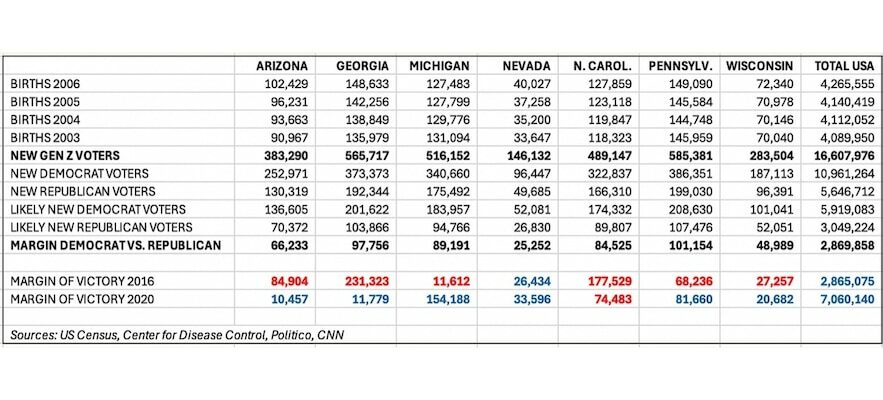Newsletter Editor The Wednesday Letter and the site Populyst (a contraction of Population and Analyst), both focused on finance, demographics, artificial intelligence and geopolitics, New Yorker Sami J. Karam was previously the founder of an investment fund focused on the American and European markets. His analysis of the demographic evolution of the seven “pivot states” crucial for the presidential election on November 5 (Arizona, Georgia, Michigan, Nevada, North Carolina, Pennsylvania, Wisconsin) reveals that the youngest voters could tip the balance in favor of the Democratic candidate.
In your opinion, the demographic evolution of the United States works in favor of Kamala Harris. In what way?
Since 2020, more than 16 million members of “Generation Z” have reached voting age. These first-time voters, born between 2003 and 2006, are now aged 18 to 21. However, this category votes mainly for Kamala Harris’ Democratic Party, for two-thirds of them. Even if we subtract 6 million abstainers from this population of 16,607,976 million (see graph), there remain more than 10 million voters, of whom nearly 6.5 million – I’m rounding up – lean towards Harris and only around 3.5 million towards Donald Trump. This represents a differential of almost 3 million votes in favour of the Democratic candidate (2,869,858 to be exact).
On the other hand, more than 8 million of the baby boomers will not show up at the polls, either because of their death or because of their advanced age. However, these people tended to vote Republican in a proportion of 55% against 45%. That is a fairly small differential. Based on these two simple observations (concerning Generation Z and the baby boomers), it is easy to conclude that demographic changes are more in the Democrats’ favor. Harris could therefore improve Biden’s 2020 result by at least 3 million votes. For the record, Hillary Clinton and Joe Biden both won the popular vote nationally: “Hillary” attracted 65 million votes to Trump’s 62—a three million vote lead—while Biden won with 81 million votes to 74—a seven million lead.
Certainly, but as the election of Trump in 2016 proved, the election is not played out by absolute suffrage but at the level of the electors…
Indeed, the president is elected by the electoral college, not by popular vote. So we need to look at demographic trends by zooming in on the state level, and more specifically on the level of each of the seven swing states, to see if the numbers cited above are relevant at the local level. And they are.
Demographic evolution: the new voters of generation Z
© / Populyst, US Census, CNN, Politico, Center for Disease Control.
Consider Arizona. What do we see? There are 383,290 more Gen Z voters than there were in 2020. Based on the turnout of this age group in 2020 and their likely 2-1 preference for the Democratic candidate, there will be 136,605 new votes for Harris and 70,372 for Trump in this state, with Harris leading by 66,233 votes among this age group. For comparison, I have shown in my chart the overall margin of victory (all ages) in 2016 and 2020 [NDLR : les deux dernières lignes].

Sami J. Karam, editor of the confidential newsletter “The Wednesday Letter” and the site Populyst (a contraction of Population and Analyst), both focused on finance, demography, artificial intelligence and geopolitics.
© / Personal collection
Let’s take this further. In Arizona, Biden’s narrow margin of victory was 10,457 voters ahead of the Democratic camp in 2020. By my calculation, Kamala Harris could improve that margin by another 66,233 votes and thus win by 75,000 votes. In Georgia, she would improve her lead by 97,000 ballots; in Michigan, by 89,000; in Nevada, by 25,000; in Pennsylvania by 101,000; in Wisconsin by almost 49,000. She could even win North Carolina: Trump won in 2020 by 74,483 votes; this year, the 84,525 new votes from Generation Z could reverse the trend. Kamala Harris could therefore consolidate the lead already recorded in 2020, win the seven “swing states” and even crush Trump by a landslide in her favor. I say this in a completely non-partisan and independent manner based on simple statistical calculations.
But the arrival of Generation Z is not the only factor!
Of course, what I’m saying is not an exact science. My analysis is inherently imprecise because of several other factors. It assumes that all else remains equal, which is clearly not the case. It also assumes that turnout will be similar to 2020, that it will be the same in all states, and that preferences will remain the same across age groups. In addition, it would have to take into account other parameters, such as relocation and migration from one state to another, and also the vote of naturalized immigrants—which could be another advantage for Kamala Harris.
Still, two things remain true. First, demographic change is increasing the Harris vote, primarily due to the arrival of new Gen Z voters and secondarily the gradual withdrawal of baby boomer votes. Secondthis development is probably significant enough to swing states in Harris’ favor.
Exactly, what weight will the baby boomers’ vote have?
In fact, the demographics are even more unfavorable to Trump if we take into account the number of baby boomer votes that will disappear in 2024 compared to 2020, due to deaths or lower turnout in later-life elections. About 8.5 million baby boomer votes will disappear, including 4.8 million Republicans and 3.7 million Democrats, a loss of 1.1 million votes for Trump.
In your opinion, is Trump’s campaign speech appropriate to the situation?
Not really. Accusing Kamala Harris of being a “communist” is ineffective beyond the base of Trumpist voters. Attacking her on her origins is no more effective. African-Americans see her as one of their own while Indian-Americans see her Indian origins. Everyone also knows that she belongs to the power elite and that she is married to a white man. So she speaks to all communities. And let’s not forget women!
Barring a major mistake by the candidate, we will probably see the same campaign dynamic as in 2008 with candidate Barack Obama, with the theme of hope, renewal and optimism. It is undeniable that the Democratic camp is bringing a breath of fresh air to the campaign. We sense an excitement that, personally, I do not share. I would have preferred a candidate with more density, depth and experience in foreign policy in this period of major geopolitical stakes. But my opinion matters little. What matters to the Democrats is to seduce young people, women and minorities. And Harris is well positioned to do so.
Does Trump’s campaign seem to be off to a good start?
At the moment, no. The contrast with Harris’ candidacy is undeniable. Now he’s the one who seems old. People seem tired of Trump’s rhetoric, which is mostly negative. There’s an erosion linked to the fact that he’s been omnipresent since 2015. In addition, Donald Trump is sabotaging himself by using words like bitchwhich in French means “slut” or even worse, to refer to Harris.
This is not how he will win over the undecided. His running mate J.D. Vance’s statements on abortion or “cat women” (i.e., women without children who understand nothing about the future of the country) will not help him either. Trump would be better advised to talk about immigration, inflation or even his foreign policy record, which was not bad. But he seems to prefer attacks ad hominem on the person of Kamala Harris.
Was the choice of Tim Walz as her running mate a smart one?
His profile is interesting. Beyond his political positions, he is reassuring for the middle class. A former teacher and sports coach, his world is very far from that of finance and Wall Street. He is neither from the East Coast nor the West Coast, that is to say outside the New York-California axis. He has his roots in distant Nebraska, in the middle of the country, and presides, as governor, over the destiny of Minnesota which has certainly been a Democratic state for decades but which is also a place in the Midwest where the traditional values of family, effort, merit, and patriotism are cherished.
Finally, he is not rich. His fortune has been estimated at $300,000 (269,000 euros), which is not much for a politician of his age. It is even unheard of. Think of Nancy Pelosi, a major Democratic figure whose fortune amounts to $230 million, or even that of JD Vance. Trump’s running mate, the latter certainly comes from a modest background but his fortune today amounts to $10 million. Tim Walz’s rather ordinary profile is somewhat reminiscent of that of former President Jimmy Carter (1976-1980). In the three Midwestern states that are swing states (Michigan, Pennsylvania, Wisconsin), his style has what it takes to seduce first-time voters from Generation Z.
.
